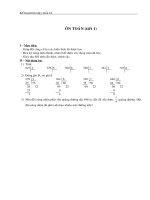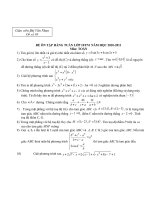Tài liệu Observations on Management of Recent Credit Default Swap Credit Events docx
Bạn đang xem bản rút gọn của tài liệu. Xem và tải ngay bản đầy đủ của tài liệu tại đây (214.3 KB, 9 trang )
Observations on Management of Recent
Credit Default Swap Credit Events
March 9, 2009
Senior Supervisors Group
OBSERVATIONS ON MANAGEMENT OF RECENT CREDIT DEFAULT SWAP CREDIT EVENTS
March 9, 2009
Mr. Mario Draghi, Chairman
Financial Stability Forum
Bank for International Settlements
Centralbahnplatz 2
CH-4002 Basel
Switzerland
Dear Mr. Draghi:
I am pleased to send you the report of the Senior Supervisors Group, Observations
on Management of Recent Credit Default Swap Credit Events. The report summarizes a
review that the Senior Supervisors Group initiated in December 2008 to assess how
firms manage their credit default swap activities and positions following a credit event.
This review was conducted to support the priorities established by the Financial Stability
Forum, including enhancing the infrastructure for over-the-counter derivatives markets
and encouraging market participants to act promptly to ensure that the settlement, legal,
and operational infrastructure underlying these markets is sound.
The observations in the report are based on discussions with senior management
of selected institutions, including major dealers, buy-side firms, service providers, and
an industry association. Overall, market participants confirmed the effectiveness of the
existing auction-based settlement mechanism and support the effort to permanently
incorporate the mechanism into standard credit derivatives documentation.
The prudential supervisors that have been involved in these initiatives will continue
to monitor and assess the ongoing progress.
Sincerely,
William L. Rutledge
Chairman
CANADA
Office of the Superintendent
of Financial Institutions
FRANCE
Banking Commission
GERMANY
Federal Financial
Supervisory Authority
JAPAN
Financial Services Agency
SWITZERLAND
Swiss Financial Market
Supervisory Authority
UNITED KINGDOM
Financial Services Authority
UNITED STATES
Board of Governors of the
Federal Reserve System
Federal Reserve Bank
of New York
Office of the Comptroller
of the Currency
Securities and Exchange
Commission
SENIOR SUPERVISORS GROUP
Transmittal letter
I. INTRODUCTION . . . . . . . . . . . . . . . . . . . . . . . . . . . . . . . . . . . . . . . . . . . . . . . . . . . . . . . . . . . . . 1
CONCLUSIONS . . . . . . . . . . . . . . . . . . . . . . . . . . . . . . . . . . . . . . . . . . . . . . . . . . . . . . . . . . . . . . . 2
III. DISCUSSION OF KEY OBSERVATIONS . . . . . . . . . . . . . . . . . . . . . . . . . . . . . . . . . . . . . . . . . . 3
A. Hardwiring of the Auction Process into Standard Credit
Derivatives Definitions
. . . . . . . . . . . . . . . . . . . . . . . . . . . . . . . . . . . . . . . . . . . . . . . . . . . . . 3
B. Structure of the Auction Process . . . . . . . . . . . . . . . . . . . . . . . . . . . . . . . . . . . . . . . . . . . . . 4
C. Centralized Infrastructure and Standardized Procedures. . . . . . . . . . . . . . . . . . . . . . . . . 4
D. Staffing Constraints for Credit Event Management. . . . . . . . . . . . . . . . . . . . . . . . . . . . . 5
APPENDIX: BACKGROUND ON CDS SETTLEMENT . . . . . . . . . . . . . . . . . . . . . . . . . . . . . . . . . 6
CONTENTS
1
OBSERVATIONS ON MANAGEMENT OF RECENT CREDIT DEFAULT SWAP CREDIT EVENTS
I. INTRODUCTION
In the second half of 2008, an unprecedented twelve credit
events for credit default swaps (CDS) occurred, resulting in
the termination of a large number of credit derivatives
contracts. Managing the operational, liquidity, and credit risks
of these events can pose challenges to financial market
participants. A core element of addressing these challenges is
the auction-based settlement mechanism, introduced by the
industry in 2005, which enables net cash settlement of the
affected contracts. The mechanism’s effectiveness in turn
depends upon full market consensus, adequate transparency,
reliable supporting infrastructure, and dedicated resources of
market participants. (Background information on CDS
settlement following a credit event can be found in the
appendix.)
In light of these events, the Senior Supervisors Group
recently assessed how well firms manage their credit
derivatives activities and positions following a credit event.
1
The review was conducted in support of the priorities
1
The Senior Supervisors Group comprises senior financial supervisors from
seven countries, with supervisory agencies representing the Canadian Office of
the Superintendent of Financial Institutions, the French Banking Commission,
the German Federal Financial Supervisory Authority, the Japanese Financial
Services Agency, the Swiss Financial Market Supervisory Authority, the U.K.
Financial Services Authority, and, in the United States, the Office of the
Comptroller of the Currency, the Securities and Exchange Commission,
and the Federal Reserve.
published by the Financial Stability Forum, which include
enhancing the infrastructure for over-the-counter derivatives
markets and encouraging market participants to act promptly
to ensure that the settlement, legal, and operational
infrastructure underlying these markets is sound.
2
To gain a perspective on the effectiveness of credit event
management practices across the industry, the Senior
Supervisors Group held discussions with senior members
of twelve institutions, comprising four major dealers, four
buy-side firms, three service providers, and one industry
association. Each surveyed participant was interviewed on the
credit, legal, and operational capabilities, challenges, and
lessons learned from its management of recent credit events.
To assess the effectiveness of credit event management
across a diverse range of events, the discussions focused on the
credit events involving two U.S government-sponsored
enterprises (Fannie Mae and Freddie Mac), a major primary
dealer (Lehman Brothers Holdings Inc.), and a European
bank (Landsbanki Islands hf).
2
See the Financial Stability Forum’s report of April 7, 2008, <http://
www.fsforum.org/publications/r_0804.pdf>, and its Follow-up on
Implementation report of October 10, 2008, <orum
.org/press/pr_081009f.pdf>.
2
OBSERVATIONS ON MANAGEMENT OF RECENT CREDIT DEFAULT SWAP CREDIT EVENTS
II. CONCLUSIONS
Overall, the review confirmed the effectiveness of the existing
auction-based settlement mechanism. Surveyed participants
reported that the recent credit events were managed in an
orderly fashion, with no major operational disruptions or
liquidity problems. Below is a summary of the review’s main
conclusions, which are designed to ensure that market
participants continue to improve their processes to effect
timely and orderly settlement of CDS contracts.
• Effective credit event management depends upon
certainty and full participation. Thus, market
participants’ support of the International Swaps and
Derivatives Association’s (ISDA) publication of the
auction supplement to its 2003 Credit Derivatives
Definitions as well as publication of a “big bang”
protocol will help to reduce uncertainty and make
credit event management more operationally efficient.
• Access to accurate CDS counterparty exposure data is
essential to efficient credit event processing. Therefore,
having all CDS trade information in one centralized
infrastructure will make it easier for firms to identify
affected trades. It can also facilitate handling of various
lifecycle events, such as settlement and credit event
processing. To this end, firms are continuing to load
existing CDS client trades into the Depository Trust &
Clearing Corporation’s (DTCC) Trade Information
Warehouse (TIW), which will allow them to utilize its
credit event processing platform, as well as conduct
central settlement through CLS, to facilitate cash
settlement of CDS trades and maximize the benefits of
multilateral netting among counterparties.
• Engagement of all market participants in decision-
making with regard to all phases of the credit event
management process will help promote a broader
market consensus and encourage more equitable market
prices.
• Formalizing market-wide and internal procedures will
reduce the operational risk associated with auctions
and help market participants address unexpected
developments. Additionally, periodic reevaluation
and enhancement of the auction process may prove
beneficial.
• Investment by firms in the necessary operational
infrastructure and training resources for credit event
management will assure efficiency, accuracy, and
timeliness of CDS settlement.
All of these conclusions reinforce the current industry and
regulatory initiatives for the over-the-counter derivatives
markets. The prudential supervisors that have been involved
in these initiatives will continue to monitor and assess the
ongoing progress.
3
OBSERVATIONS ON MANAGEMENT OF RECENT CREDIT DEFAULT SWAP CREDIT EVENTS
III. DISCUSSION OF KEY OBSERVATIONS
According to all surveyed participants, the credit events in the
latter half of 2008 in general were managed in an orderly
fashion, with no major operational disruptions. While many
participants reported resource challenges and some buy-side
firms stressed the need for greater fairness in the auction
process, the participants agreed that recent significant
improvements in CDS infrastructure, risk management,
operations, legal capabilities of firms, and communication all
contributed to a credit event management process that
resulted in the successful settlement of CDS trades.
One quantifiable outcome as a result of credit event
management is that even though the gross notional value of
credit derivatives contracts written on Lehman Brothers was
approximately $72 billion, the net cash flows were only a
fraction of that amount—approximately $5.2 billion
U.S. dollar equivalent in net funds was paid out.
3
Overall, participants held a positive view of the mechanics
of the auction process, and the participation rates in each
of the four auctions exceeded 95 percent. Those client
participants that chose to settle bilaterally outside the auction
process reportedly did so to close out positions prior to the
determined auction date or because they believed that the
small number of affected CDS trades on their books did not
warrant the resources necessary to participate in an auction.
All of the participants quickly identified affected trades on
the same day (within minutes to a few hours), and their risk
management and operational staffs collaborated to monitor
and manage credit derivatives positions and related
counterparty exposures. All participants indicated that they
were monitoring these high-risk names, even before a credit
event had been declared.
The majority of participants elected to cash-settle affected
CDS transactions. However, two buy-side firms submitted
physical settlement requests during the Lehman Brothers
auction, because they were uncertain about the recovery rate
for Lehman Brothers debt—particularly in light of the Fannie
Mae and Freddie Mac auctions, in which there were
unexpected outcomes in the final prices of the underlying
debt.
4
All participants, including the service providers, reported
that all phases of the auctions were conducted within the
scheduled timeframes. In addition, information at the
3
For information on the Lehman Brothers and other recent credit events,
see @DTCC News, November 2008, < />dtcc/2008/nov/index.php>.
conclusion of each phase of an auction, as well as the final
results at the close of an auction, was announced in a timely
manner on the Creditex and Markit websites.
Participants did not observe any differences between the
CDS auctions and credit event processes in the United States
and Europe, although varying levels of experience and
knowledge were observed among credit event management
staffs. Participants indicated that most of the expertise in
credit event management was in the United States. Two
participants noted that they were working to expand such
expertise in Europe.
A. Hardwiring of the Auction Process into
Standard Credit Derivatives Definitions
In 2008, market participants announced plans to incorporate
the auction protocol permanently by means of an auction
supplement to the ISDA 2003 Credit Derivatives
Definitions.
5
At the same time, ISDA plans to publish a “big
bang” protocol that will provide market participants with an
operationally efficient means to amend their existing CDS
trades to utilize the auction mechanism in connection with
future credit events.
Market participants, by signing, agree to adhere to the
auction and settlement process stipulated in the published
supplement and protocol. However, the target date for
incorporating the supplement into the ISDA definitions has
been delayed from December 2008 to early April 2009
because of the large number of credit events in 2008.
The orderly and equitable management of credit events
depends upon market consensus on the various decisions and
determinations made throughout the process. At any point,
disputes among participants may arise, such as over the
determination of which obligations are eligible for delivery in
the final settlement. Survey participants reported that ISDA is
4
In the Fannie Mae and Freddie Mac auctions, the recovery rate for the
subordinate debt ended higher than the rate for the senior debt—a first in CDS
auction history. This outcome was attributable to an open buy interest from
protection sellers because Fannie Mae’s and Freddie Mac’s subordinated debt
bonds are still performing and provide a natural hedge for naked protection
sellers, thus pushing recovery rates close to par. Final recovery rates for Fannie
Mae and Freddie Mac senior debt were 91.51 percent and 94 percent,
respectively, while the recovery rates on subordinated debt were near par,
at 99.9 percent and 98 percent, respectively.
5
See the July and October 2008 industry commitment letters to regulators,
< This priority
is also in line with statements made by the President’s Working Group and the
Financial Stability Forum in March and April 2008, respectively.
4
OBSERVATIONS ON MANAGEMENT OF RECENT CREDIT DEFAULT SWAP CREDIT EVENTS
leading an effort to develop a standard mechanism to resolve
such disputes. Some firms noted that a dispute resolution
mechanism that is viewed as opaque, ambiguous, or biased
may discourage participation in the auction process and
ultimately may dissuade some participants from accepting the
final hardwiring into the credit derivatives definitions. In
particular, some buy-side firms noted that the committee
resolving disputes should also account for the buy-side
perspective. These firms cited the manner in which deliverable
obligations were determined for the Fannie Mae and Freddie
Mac credit events as examples of decision-making without
sufficient buy-side input.
B. Structure of the Auction Process
Overall, while the auction process was viewed as effective in
achieving an orderly settlement of CDS trades of a defaulting
reference entity, some firms cited the need for a more
equitable auction process and adjustments to the auction
structure. In this regard, some buy-side firms expressed a
desire for more direct participation in the auctions;
6
they also
suggested using an independent third party to accept client
orders during the auctions to eliminate any information
asymmetry between dealers and buy-side firms as well as to
prevent a dealer from potentially using its knowledge of
positions to skew the results.
Dealers expressed a differing view, indicating that the
auctions were designed to enable them to fulfill their role as
market-makers and liquidity providers. They noted that the
auction structure includes reasonable checks and balances to
address some of the concerns of the buy-side firms.
The concept of direct participation by buy-side firms was
not universally endorsed by the buy-side firms surveyed, as
some noted that as a practical matter many customers are
prohibited from directly participating in the making of two-
sided markets for tax, business, regulatory, or other reasons. In
addition, a few buy-side firms indicated that it would be
operationally difficult and costly to introduce an independent
third party because dealers must act as intermediaries in credit
events.
Major dealers and some buy-side firms indicated that
having an additional layer of complexity is not worth the
return at this point in the hardwiring process. They did agree
6
Currently, only dealer firms can submit bids, offers, physical settlement
requests, and limit orders on behalf of buy-side firms.
that engaging a wide range of market participants in the
hardwiring design and gaining their confidence in the auction
process will help build broad support for hardwiring.
C. Centralized Infrastructure
and Standardized Procedures
The management of multiple credit events in a short time
period gave market participants considerable operational
experience under conditions of stress. As a result, participants
reported gaining useful insight into the most difficult
challenges, which allowed them to suggest concrete
improvements to the process.
Participants noted that leveraging existing critical
infrastructure for credit event processing enables a firm to
quickly identify and assess its counterparties, the affected trade
populations, and risk positions; it also enables the market as a
whole to determine a settlement price and carry out efficient
cash settlement in an orderly manner.
For example, DTCC’s credit event processing service
enabled firms to manage the large number of affected CDS
trades during the recent events. Moreover, DTCC offered an
additional capability to process tranche trades, starting with
the Washington Mutual credit event in October 2008. All
surveyed participants indicated that without the DTCC
service and the TIW, the process would have been manual and
burdensome and they could not have completed timely
processing.
Having CDS trades in the TIW platform allowed market
participants to quickly identify their affected trade
populations and the counterparties to be notified. The major
dealers reported that most of their interdealer trades were
backloaded into the TIW in early-to-mid-2007, and they are
continuing to backload dealer-to-client trades. In addition, a
few buy-side firms have backloaded a significant volume of
outstanding trades into the TIW. However, while the
population of existing interdealer trades has been backloaded
into the TIW, a proportion of existing client trades and trades
that are not sufficiently standardized remains outstanding.
Some survey participants noted that backloading more CDS
trades into the TIW would broaden its operational benefits.
All firms observed that market-wide adherence to well-
established and standardized procedures, as well as a
centralized flow of information, greatly reduced uncertainty.
One standardized process, implemented after several credit
event auctions, was the publication on ISDA’s website of
counterparty identifier codes for the Uniform Settlement
5
OBSERVATIONS ON MANAGEMENT OF RECENT CREDIT DEFAULT SWAP CREDIT EVENTS
Agreement. Market participants viewed this as a helpful
change because it enabled them to easily identify their
counterparties by legal entity and see whether their
counterparties were signatories on the agreement for credit
event notification.
The settlement process has also become more standardized
through the processing of some cash payments through CLS.
CLS typically facilitates coordinated cash settlement of CDS
coupon payments, receiving payment information directly
from the TIW. CLS offers multilateral netting among all
member participants, which further streamlines the settlement
process. The major dealers found the automated process
between DTCC and CLS to be seamless and efficient, and it
eliminated the manual process of bilaterally settling payments.
Currently, only dealer firms are member participants, but
DTCC will expand its services to end-users in 2009 to increase
the benefits of multilateral netting among counterparties. In
addition, CLS and DTCC will further shorten the time
required to flow credit event payment information between
each other and to participants, so that they can become aware
of projected payments and proactively manage them.
CDS market service providers reported that their system
capacities continued to meet the operational demands of
credit event processing and settlement arising from the recent
events. They noted that the workflow did not differ from that
of a typical day, but they did experience higher volumes and
larger payment amounts.
The recent credit events also helped clarify the process
among the various industry groups for discussing and
resolving credit event management issues. This has resulted
in certain ad hoc groups—such as the Credit Steering
Committee and legal working groups—coalescing, identifying
key responsibilities, and meeting more often to discuss
relevant topics and industry initiatives, such as standardizing
CDS, improving operational efficiency, and enhancing the
market infrastructure.
Timely and open communication, externally among
market participants and internally within firms, was seen as
instrumental to the orderly management of credit events. In
particular, participants cited the need to respond swiftly and
coordinate with others when problems arise. During the CDS
auction for Lehman Brothers, dealers quickly realized that
they would not have enough time to enter the large number of
limit orders. In response, ISDA convened a conference call
within minutes of the second phase of the auction, and dealers
decided to extend the auction a half-hour. This action was
cited as an example of the benefits of efficient, standardized
communication among market participants, who may have to
coordinate and resolve problems under critical time pressures.
The market service providers and industry associations were
recognized for playing key roles in facilitating centralized
communication during the process.
D. Staffing Constraints for Credit
Event Management
Firms reported limited operational staff to address the
occurrence of multiple contemporaneous credit events.
Service providers also cited the importance of firms’
preparedness, and observed that dealer staff in the United
States required more training and guidance during the auction
process than did European traders.
Upon determination of a credit event, dealer firms must
appoint a trader to act on behalf of both the dealer and its
various clients. Between credit event determination and the
actual auction date, service providers train the appointed
traders to use the auction trading platform, familiarize traders
with the auction rules and procedures, and ensure that dealer
systems are operationally compatible.
Service providers noted that each time a credit event
occurred for a different sector of CDS trades, the appointed
traders would change, since firms wanted to use traders with
expertise in the sector. Of the twelve credit events that
occurred last year, only three were European. However, service
providers reported that European traders’ familiarity with the
trading platform, due to the greater take-up of electronic
trading in Europe, made a large difference in terms of trader
preparedness. In the United States, where trades are still voice-
brokered, traders required more time to learn the platform.
Some surveyed firms observed that the rapid succession of
multiple credit events in the second half of 2008 provided
their staffs with the critical knowledge, skill, and experience
to manage simultaneous events. They felt that the live
experiences broadened their understanding of CDS settlement
and helped them to identify areas of improvement.
6
OBSERVATIONS ON MANAGEMENT OF RECENT CREDIT DEFAULT SWAP CREDIT EVENTS
Following a credit event, CDS trades can be physically settled
or cash-settled. In physical settlement, the CDS protection
buyer transfers ownership of the actual debt obligation to the
CDS protection seller in exchange for the notional amount of
the contract. However, this transaction could result in
valuation distortions in which the aggregate notional amount
of CDS written on a particular entity is significantly larger
than the amount of the entity’s actual debt obligations in the
market, what is known as a short squeeze. In cash settlement,
the parties agree upon the price for the deliverable bonds and
settle their claims on a net cash basis. Achieving agreement on
valuation after a default, however, is challenging. To address
the challenge, in 2005 the industry developed an auction
mechanism to establish a fair price for assets in default, thereby
enabling net cash settlement of affected contracts. Regulators
have cited cash settlement through universal use of the auction
mechanism as preferable to bilateral physical settlement
because the auction mechanism reduces the risk of price
distortions and allows for CDS contracts to settle in a timely
manner.
Management of a CDS credit event involves a number of
steps, from declaration of a credit event to settlement of
payments. Notification of a credit event triggers the
termination of CDS contracts and requires the settlement of
CDS trades among sellers and buyers. To determine whether
a credit event has occurred, and whether an auction has to be
conducted, ISDA holds an open conference call with market
participants to vote and reach consensus on the contracts to
be terminated and on whether the amount of affected
transactions is large enough to warrant an auction.
Once a credit event is determined, market participants
must identify their affected positions and protection buyers
and sellers must notify their counterparties of the terminations
through the use of an official credit event notification. ISDA
has established a more efficient way to manage the credit event
notification process by publishing a standard notice known as
the Uniform Settlement Agreement, which obviates the need
for participants to engage in multiple bilateral credit event
notifications. This notice represents multilateral agreement
among market participants, whereby signatories agree that a
credit event has occurred and that they will settle the affected
CDS contracts accordingly.
The next step is to establish the auction terms and a
standard protocol to which market participants must adhere to
effect cash settlement. Since 2005, firms have participated in a
series of ad hoc auctions to establish a fair market price used
for final cash settlement of CDS. ISDA coordinates the effort
to publish the ad hoc protocol and to establish the auction
terms, including the list of obligations eligible for delivery.
Currently, market participants are not required to adhere to
this protocol, and can choose to settle their contracts
bilaterally outside the auction process. However, permanently
incorporating—hardwiring—the auction mechanism into the
ISDA’s 2003 Credit Derivatives Definitions would mandate
that all counterparties participate in the auction process,
promoting more certain, fair, and orderly settlement.
7
The auction itself is carried out by Creditex and Markit,
which provide the operations and technology platform. Once
the auction terms and date are set by ISDA, each dealer assigns
a trader to participate in the auction on the firm’s own behalf
and on behalf of its clients. The auction is a two-phase process
with strict timelines for market participants to submit bids,
offers, physical settlement requests, and limit orders.
8
Creditex
and Markit publish the final price for market participants.
CDS protection buyers and sellers use the final price to
calculate the amounts due to or from their counterparties.
Currently, for participants that are customers of the DTCC
Deriv/SERV TIW and choose to use its credit event
processing service, DTCC calculates all payouts and
receivables and bilaterally nets the amounts by counterparty
and currency. For participants that are members of CLS,
DTCC provides the netted payment instructions to CLS
for central settlement. Market participants that do not use
Deriv/SERV settle payments bilaterally through their
settlement agents.
7
Unless counterparties specify otherwise in their CDS confirmation for
customized trades.
8
The auction methodology is discussed in the Credit Event Auctions Primer,
available at <>.
APPENDIX: BACKGROUND ON CDS SETTLEMENT









